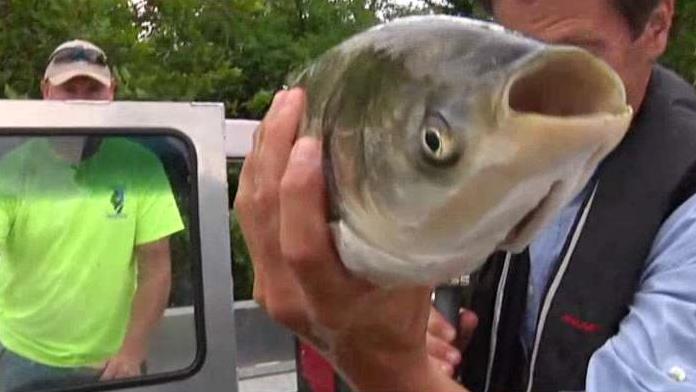'Fish Fence' hits Kentucky waters in million dollar move to curb carp
Sen. Mitch McConnell is boosting a hoped for $7 million solution to a multi-million dollar problem.
Asian carp are wreaking havoc local water ecosystems in the Midwest and the South and Friday, the Republican Senate Majority Leader from Kentucky unveiled a new, $7 million bioacoustic "fish fence" towards the bottom of the Barkley Dam, which will undergo a three-year trial in an effort to help wildlife officials determine whether or not the equipment will work in keeping Asian carp at bay.
Meanwhile, in the Great Lakes region, the state of Michigan says it remains willing to contribute $8 million toward initial stages of a similar project to prevent Asian carp from reaching the Great Lakes. Congress has been asked to cover most of the project’s $778 million costs.
Asian carp are actually four different species that have become an invasive presence up the Mississippi, Missouri and Ohio rivers, where they enter through the Gulf of Mexico and swim upstream as far as Wisconsin.
According to AsianCarp.us, “Asian carp were originally imported from Southeast Asia (first introduced in the early 1960s and 1970s) to the southern United States to help aquaculture and wastewater treatment facilities keep retention ponds clean. Flooding and accidental releases allowed these fish to escape into the Mississippi River system and migrate into the Missouri and Illinois rivers.”
The "fish fence" broadcasts noises in a frequency that will deter the carp from making their way upstream, with the noise being contained by a barrier of bubbles illuminated with strobe lights. Thus far, laboratory results have been promising.
ILLINOIS SEEKS TALKS ON KEEPING ASIAN CARP FROM GREAT LAKES
The Barkley Dam was chosen for the first large-scale fish fence test due to the fact that Asian carp have been there now for years, with their movements being easy to track. The Kentucky Department of Fish and Wildlife Resources also have a fulltime team at the dam who have been observing the invasive carp.
Meanwhile, Kentucky Aquatic Nuisance Species program director Ron Brooks revealed that the agency has already been tagging Asian carp and species native to the area with transmitters to monitor their actions while the fish fence is being installed.
"If it looks really good by the summer of next year there is going to be a push to bring the research to other sites," Brooks said. "They're going to look for where the next best places are to test."
Asian carp have made a huge impact on local ecosystems -- and not in a good way. Their primary food source is plankton, also the food source of mussels, infant fish and several adult species of fish. The carp not only eats the plankton for others, but Black Carp also eat already severely-endangered snails and mussels. Also another version of the fish, the U.S. Grass carp voraciously eats aquatic plants, taking food sources away from other native fish.
ILLINOIS GOVERNOR OKS FIRST STEPS ON BLOCKING ASIAN CARP
Perhaps most disturbing, silver carp actually jump out of the water whenever boats come near them, getting “slime and blood everywhere and hurt equipment," Brooks added.
McConnell told the crowd that he has secured a record $25 million in the Senate’s budget for the explicit purpose of controlling the Asian carp population, which he said will "protect Kentucky's $1.2 billion fishing industry and help it continue to grow."
Some of that money was provided by the Great Lakes Restoration Initiative, with Great Lakes regional director for the U.S. Fish and Wildlife Service Charles Wooley stating the fish fence could be used in the Great Lakes and elsewhere should the technology prove effective.
In April, the Governor of Illinois gave the green light for the state to begin taking measures to protect Lake Michigan from the invasive Asian carp.
"I would like to discuss how we can lower the cost of this plan and still effectively address the threat of Asian carp," Governor J.B. Pritzker said. "I will not sign a Project Partnership Agreement without a cost control strategy and additional cost sharing among the states."




















